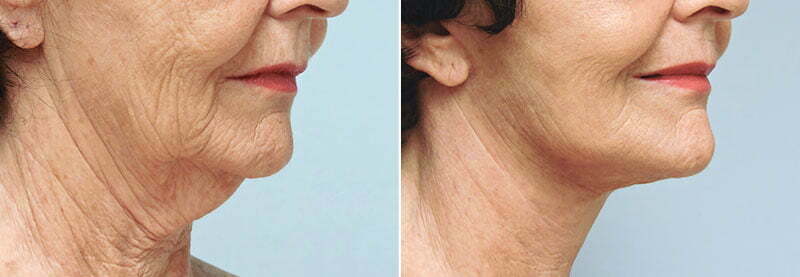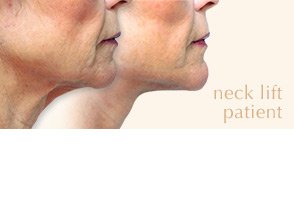Your Neck Might Be Aging Faster Than Your Face: Here’s Why

It’s not just you–for many people, the skin on the neck seems to age more quickly than the face. In this post, Asheville plastic surgeon Dr. Donald Conway explains why you may see signs of aging on your neck before you see them on your face, and shares several effective treatment options—both surgical and non-surgical—to help you restore a more youthful neck appearance.
Why does the neck seem to age faster?
There are several anatomical and external factors that contribute to the accelerated aging of the neck:
- Thinner Skin: Neck skin is thinner than facial skin, so as your natural collagen and elastin stores are depleted over time, laxity, wrinkles, and sagging will occur faster in the delicate skin of the neck before these same effects impact facial skin.
- Limited Oil Glands: Unlike the face, the neck has fewer sebaceous glands, so it does not retain as much moisture in the skin. Dry, thin skin is what creates a crepey appearance in the neck.
- Repetitive Movement: The neck is in constant motion. Over time, repetitive motions can result in deep horizontal lines—much like how expression-based lines form in the face. These neck lines simply need less time to form.
- Neglect in Skincare Routines: The neck is often overlooked in skincare routines. This omission leaves the neck more vulnerable to UV damage, pigmentation issues, and premature aging, as the neck is typically exposed to the same elements as the face.
- Muscle Weakening: The platysma muscle in the neck naturally weakens with age. Eventually, most patients notice vertical banding, sagging skin, and less jawline definition.

Signs of Neck Aging
Common signs of an aging neck include:
- Pronounced horizontal lines or “necklace lines”
- Loose, sagging skin, sometimes referred to as “turkey neck”
- Vertical bands caused by muscle weakening and separation
- Discoloration or uneven skin tone
- A blurring of the jawline and neck contour
Treatment Options for Neck Rejuvenation
Dr. Conways offers both non-surgical and surgical treatments to treat signs of aging in the neck, and will guide you to the right choice for your concerns during your consultation.
Non-Surgical Solutions
For those who are only dealing with early signs of aging in the neck, such as fine lines, sun damage, or uneven skin tone, you may only need a non-surgical treatment or professional product to address these minor concerns. Here are some non-surgical options to consider:
Skincare Products
Medical-grade skincare products contain more potent levels of active ingredients such as retinol, hyaluronic acid, and peptides compared to drugstore options. These higher-quality products better improve skin tone, texture, and hydration. It’s also important that you use sunscreen daily and reapply if needed to prevent further UV damage to your neck.
“I see him regularly now for Botox injections and have had laser procedures done. I have ALWAYS been happy with my results and he will be my surgeon of choice in the future for any other cosmetic surgery I have performed. His staff is amazing, I have come to know everyone in the office and just love them!”
—5-star Google review
Injectables
A combination of injectable treatments can also help refresh and maintain a more youthful-looking neck. Botox can relax the muscles that cause vertical neck bands, while dermal fillers can add just enough natural volume to soften horizontal lines. Many patients use injectables to both improve or delay signs of aging in the neck, and appreciate the quick treatments and no downtime.
Laser Treatments
Laser resurfacing is highly effective in reducing a range of skin concerns including pigmentation, mild skin laxity, fine lines, and other mild to moderate signs of aging. These treatments help clear surface imperfections and stimulate collagen production to plump the skin and increase its resilience to aging.
Surgical Solutions
Once more advanced signs of neck aging start to appear, surgical procedures will be the most effective option and can provide longer-lasting results:
Neck Lift Surgery
A neck lift is the gold standard for effectively correcting aging in the neck. During this procedure, Dr. Conway removes excess skin and tightens the underlying platysma muscle to restore definition to the neck and jawline. In many cases, a facelift is also performed during the same surgery for comprehensive rejuvenation.
Liposuction
Depending on the cause of your concerns, Dr. Conway may recommend submental liposuction to remove excess fat beneath the chin that creates unwanted fullness in the area and obscures your natural jawline and profile. Chin liposuction can be performed as a single procedure or incorporated into a neck lift surgery plan for optimal results.
Considering Treatment for an Aging Neck?Board-certified plastic surgeon Dr. Donald Conway specializes in surgical and non-surgical neck rejuvenation. Your customized treatment plan will be thoughtfully designed to achieve long-lasting results that preserve a natural appearance. To schedule your consultation with Dr. Conway, we invite you to contact our Asheville plastic surgery center at 828-210-9333 or reach out online.
References »
Kim E, Cho G, Won NG, Cho J. Age-related changes in skin bio-mechanical properties: the neck skin compared with the cheek and forearm skin in Korean females. Skin Res Technol. 2013 Aug;19(3):236-41. doi: 10.1111/srt.12020. Epub 2013 Feb 26.
Pérez P, Hohman MH. Neck Rejuvenation. [Updated 2023 Sep 4]. In: StatPearls [Internet]. Treasure Island (FL): StatPearls Publishing; 2025 Jan-. Available from: https://www.ncbi.nlm.nih.gov/books/NBK562229/
Narasimhan K, Stuzin JM, Rohrich RJ. Five-step neck lift: integrating anatomy with clinical practice to optimize results. Plastic & Reconstructive Surgery. 2013 Aug;132(2):339-350. doi: 10.1097/PRS.0b013e3182958b6f.
Leave a Comment:



